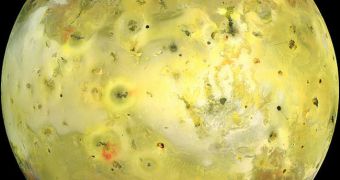Astronomers consider the volcanic Jovian moon Io to be one of the prime candidates for the existence of life in the solar system, in places other than Earth. Experts believe that the environment on the small celestial body is similar to that of our planet, in its distant past.
Io is widely considered to be the most volcanically-active body in the solar system, even more so than Earth. It is the innermost of Jupiter's large moons, and scientists believe that the massive gravitational pull of the gas giant is responsible for causing these events.
Eruptions are so strong there that the plumes volcanoes release can reach altitudes of up to 300 kilometers (186 miles). Given the violence of these events, as well as the amount of heat they generate, it makes sense why astrobiologists would consider Io a prime candidate to support life.
“Everyone right away tends to categorically exclude the possibility of life on Io. Life on the surface is all but impossible, but if you go down further into the rocks, it could be intriguing,” says expert Dirk Schulze-Makuch.
“We shouldn't categorize it as dead right away just because it's so extreme,” adds the expert, who holds an appointment as an astrobiologist at the Washington State University (WSU).
He adds that the moon may have looked quite differently in its distant past. This means that, if life had a chance to develop at that time, then it may have evolved adaptations to the new conditions as well.
The possibility that life existed on Io is there, experts agree. The cosmic body formed in a Jovian orbit where there was plenty of water-ice. Combine that with the fact that volcanic eruptions are extremely hot, and you got an environment featuring Steam, or even liquid water.
“There must have been quite a lot of water on Io shortly after formation, judging from the amount of water ice on Europa and Ganymede,” Schulze-Makuch says in reference to two other interesting Jovian moons. They are also targets for scientific research today," Daily Galaxy reports.
Though Io features no surface water – radiations from Jupiter removed it some 10 million years after the moon formed – it could have water-ice beneath the surface. In 10 million years, bacteria can evolve, and already move underground to survive.
Geothermal activity and the presence of sulfur compounds are enough to provide basic microorganisms with the power source they need to survive. “I'm exploring with colleagues whether sulfur compounds could work as solvents of life,” the WSU expert says.
Speaking about the current conditions on Io, he adds: “It'd be much easier for life to take a beating if it goes dormant [underground] regularly.”

 14 DAY TRIAL //
14 DAY TRIAL //